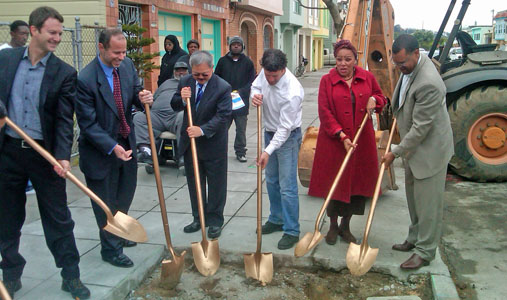The United States Environmental Protection Agency (EPA) committed nearly $500,000 of a $20 million grant awarded for San Francisco Bay water quality improvement to a project that will transform an ordinary block in San Francisco’s often-overlooked Bayview neighborhood into one of the City’s most sustainable and resident-friendly stretches.

San Francisco Mayor Ed Lee helped break ground on a project that will transform an ordinary block in the City’s Bayview neighborhood into a model of sustainable, multi-objective city planning. Photo courtesy of US EPA
By Bill Picture
Published: June, 2011
The United States Environmental Protection Agency (EPA) committed nearly $500,000 of a $20 million grant awarded for San Francisco Bay water quality improvement to a project that will transform an ordinary block in San Francisco’s often-overlooked Bayview neighborhood into one of the City’s most sustainable and resident-friendly stretches.
Construction crews broke ground last month on the Newcomb Avenue Streetscape Model Block Improvement Project, a pilot streetscape project that, among other things, will replace large areas of concrete with sidewalk planters and landscaping.
From an urban perspective, there’s nothing better you can do to improve water quality than to create green streets like this one, said Sam Ziegler, Chief of the EPA Region 9 Water Division’s Watersheds Office.
Replacing concrete with landscaping and planters that absorb rainwater lessens the strain on San Francisco’s combined sewer system. In most parts of the City, sewage and stormwater share the same network of underground pipes. Those pipes lead to treatment plants, where pollutants are removed from the wastewater mix before it’s released into the Bay.
During heavy rains, however, the system is designed to release untreated overflow directly into the Bay so that sewers don’t back up onto the streets. Less rainwater down the gutter means less chance of untreated overflow ending up in the Bay.
But water quality isn’t the only aim of the project. Ziegler is equally excited at the prospect of helping to create a more robust and livable community for the residents of the City’s southeast sector.
Its streets once heavily plagued by violence, the Bayview has over the years become what Ziegler refers to as a backyard community, meaning its residents have taken to stepping into their own backyards for fresh air instead of risking their safety in public spaces, including the sidewalks in front of their very own houses.
The result has been a sad disconnect between neighbors who live right next door to each other, and of residents from the larger community. By giving the neighborhood’s gray sidewalks a green garden touch, the project’s organizers hope to lure residents back out onto the streets, reconnecting them to their community.
And it reconnects them to the natural resources around them, said Ziegler. I’d like to see people hanging out in front of their houses again, and kids playing on the sidewalks.
In addition to making the sidewalks more attractive, Newcomb Street itself is being redesigned to make it much safer for pedestrians. The street-to-sidewalk ratio is being adjusted so that vehicles no longer have a perfectly straight path-of-travel, forcing them to reduce their speed. Crosswalks are also being raised, forcing drivers to slow as they approach.
The corners of the block are being designed to function as small gathering spaces, where neighbors can sit and chat, or play games. Besides further fostering relationships between the block’s residents, the hope is to also instill a sense of community pride and stewardship.
Block residents have already committed to working together to provide ongoing maintenance; and they have begun organizing community cleanup days to keep their block beautiful.
Through [this] process, we have come to know our [neighbors], as community activists, Newcomb Street resident Michelle Moulton told reporters.
This is what city managers everywhere need to be doing, Ziegler said. These kind of low-impact multi-objective efforts where there’s an environmental component and a public safety component and a revitalization component. San Francisco has the right idea and they are consciously working to make this be their standard practice. I really hope it catches on.
The EPA is partnering with a number of City agencies to complete the project, including the San Francisco Redevelopment Agency, San Francisco Planning Department, San Francisco Department of Public Works, San Francisco Municipal Transportation Agency and San Francisco Public Utilities Commission, and the San Francisco Estuary Partnership. The balance of the $1.6 million price tag will be paid for by the San Francisco Public Utilities Commission and San Francisco Redevelopment Agency, as well as money from a San Francisco Community Challenge Grant. The Community Challenge Grant Program awards money to local residents, business, non-profits and community groups to make physical improvements to a neighborhood.

